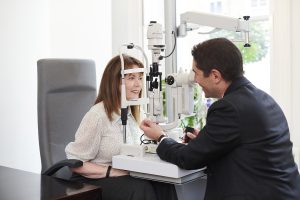Will Cataract Surgery Improve Near-Sightedness?

If you’re awaiting treatment for cataracts, you will probably want to learn as much as possible about the procedure and the results you can expect afterwards. Of course, you will expect your clouded vision to be resolved due to the removal of the cataract, but you may also wonder whether you can expect some additional benefits. For example, will Cataract Surgery improve near-sightedness?
How Does Cataract Surgery Work?
Cataract Surgery is the most commonly performed procedure in the UK and many other countries around the world. It is the only solution for cataracts – cloudy obstructions that form in our eyes’ lenses as we get older.
Cataracts begin to form as proteins begin to break down and clump together. As such, the primary aim of the procedure is simply to remove these obstructions, but Cataract Surgery can also present other benefits.
During your procedure, your surgeon will create a small incision on the surface of the cornea (don’t worry, thanks to the use of local anaesthetic, this shouldn’t hurt!). Through this incision, the cataract can be broken up and the affected lens removed from the eye. Finally, a new artificial lens – known as an intraocular lens (IOL) – is inserted to replace the natural one.
As a result, the clouded vision caused by the cataract is resolved. So, what exactly do we mean when we say that Cataract Surgery can also help to improve vision in other ways?
The Different Types of Intraocular Lenses (IOLs)
Several different types of artificial IOLs can be used to replace the natural cataract-affected lens in Cataract Surgery (as well as Clear Lens Exchange and ICL Surgery). In NHS Cataract Surgery, monofocal IOLs – lenses designed to focus on one field of vision – are exclusively used. However, there is a much wider range of “premium” IOLs available.
Premium IOLs can correct refractive errors such as myopia (near-sightedness), hyperopia (long-sightedness), and even astigmatism. In contrast to monofocal lenses, premium lenses multifocal IOLs are able to facilitate near, intermediate, and distance vision while toric IOLs can eliminate errors caused by corneal astigmatism.
What is Near-Sightedness?
Near-sightedness, also known as short-sightedness or myopia, is the most common refractive error affecting around a third of people worldwide. It occurs when the eye – or certain parts of the eye – are shaped in a way that causes light to be refracted inaccurately onto the retina. As a result, while people with near-sightedness can clearly distinguish objects that are close up, objects that are far away appear blurry.
Correcting Near-Sightedness with Cataract Surgery
Premium IOLs like those available at London Vision Clinic are capable of correcting practically all prescriptions. When planning your Cataract Surgery, we are able to choose the IOLs that are best suited to your specific prescription to ensure the best possible results. Patients who have Cataract Surgery in both eyes will achieve the best results, as both eyes will be corrected.
While most patients with near-sightedness can expect extremely good results after private Cataract Surgery, those with a high degree of myopia may be more prone to complications – such as retinal detachment – during the procedure.
High myopia is also associated with a higher risk of developing macular degeneration which can increase the risk of post-operative complications. Rigorous screening and pre-operative evaluations are essential for developing a personalised treatment plan that can help to mitigate these risks as much as possible.
If you have myopia (near/short-sightedness) and would like to learn more about the results you can expect after Cataract Surgery, don’t hesitate to get in touch with one of our friendly clinic coordinators. Alternatively, Book a Consultation at London Vision Clinic today.


